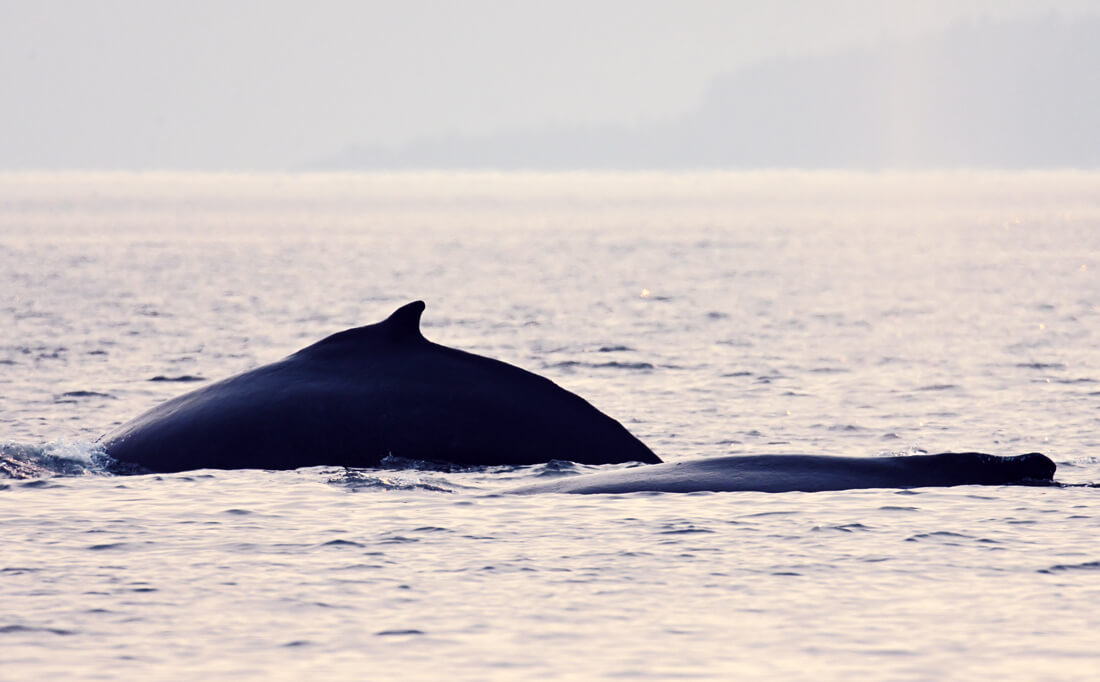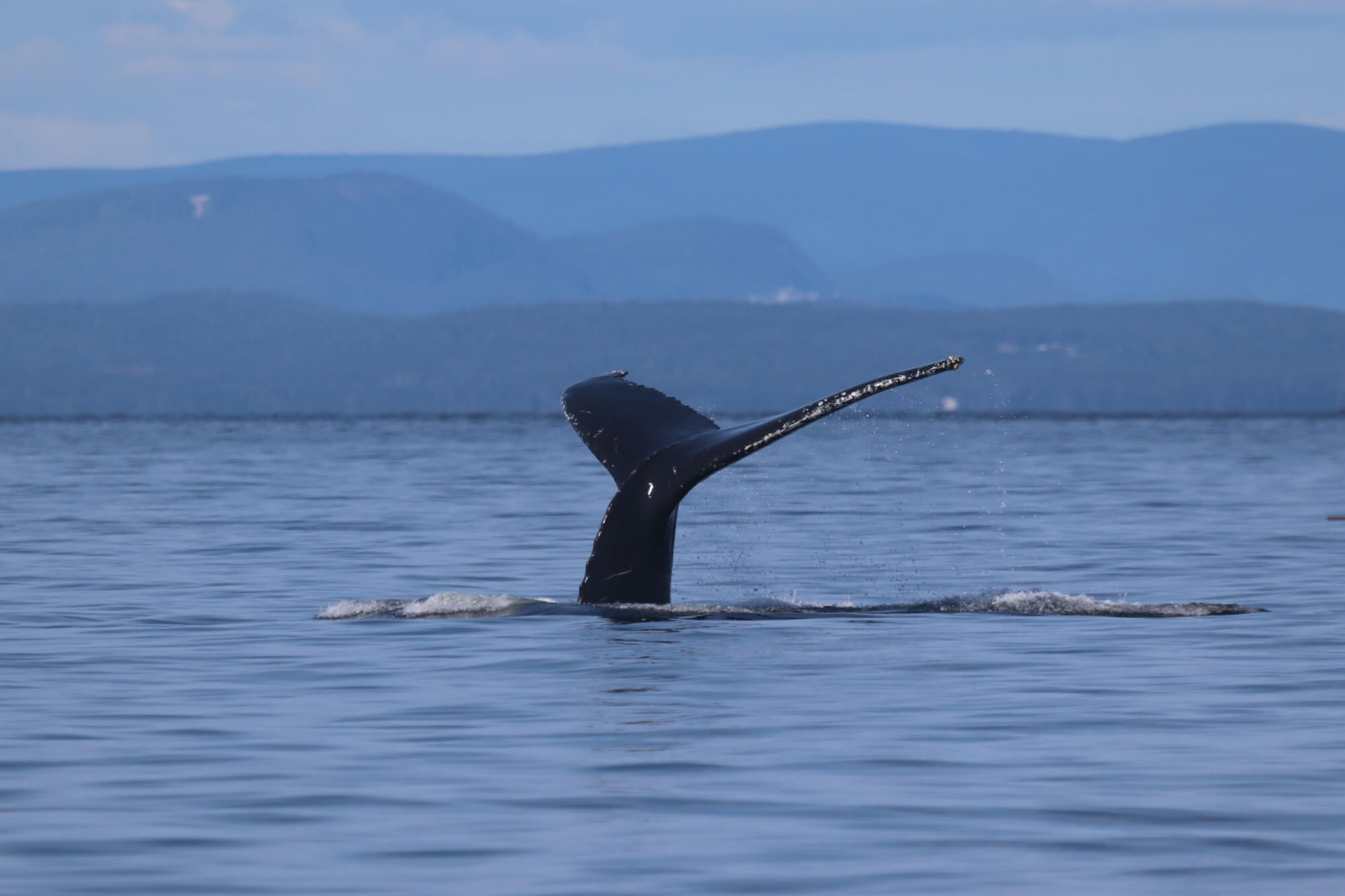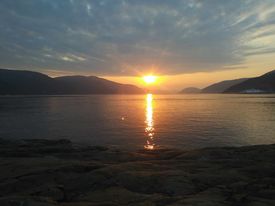A new species is visiting the Gulf of St. Lawrence for the first time this year: the sperm whale. In addition to answering the question of whether blue whales have already been seen in the Saguenay prior to this year, I will also share with you the story of a particularly inspiring day with marine mammals, including the observation of a breaching humpback that I’m unlikely to forget anytime soon!
Two sperm whales in the gulf
The Mingan Island Cetacean Study (MICS) team has had its hands full over the past week. In the Sept-Îles sector, scientists have identified five or six humpback whales, not to mention two fin whales and nearly a dozen blues. One noteworthy observation is the presence of two good-sized male sperm whales. The largest of the toothed whales had yet to be observed in the St. Lawrence this year! This species is occasionally observed in the Gulf of St. Lawrence and its estuary. They are most often males in search of new feeding grounds. GREMM’s director of education, Patrice Corbeil, who describes himself as optimistic by nature, also believes that the two sperm whales will venture into the estuary. No doubt we will see if his prediction proves correct in the weeks to come!
It’s impossible to talk about sperm whales without recalling one of the most famous members of this species: Tryphon. This male frequented the estuary between 1991 and 2009, making nearly annual incursions upriver, sometimes alone, sometimes not. Trypon’s story ended abruptly in the spring of 2009 when he became entangled in fishing gear. Although this mishap ended fatally, a few bones were recovered and are now on display at the Marine Mammal Interpretation Centre.
Life in the St. Lawrence
When it comes to stories of encounters with cetaceans, Jacques Gélineau has plenty! This marine mammal enthusiast and MICS collaborator reports the presence of harbour porpoises and grey seals in the Sept-Îlesregion. Although he has not had the chance to observe the two sperm whales, he intends to go explore the gulf in the next few days. In terms of large cetaceans, he identified two blue whales and one humpback, not to mention a notable abundance of leaping tuna! He also shares a few theories on the presence of animals in the area: “Oftentimes, when the winds are from the east, the animals leave the area and return only when they begin to blow from the northwest. He also believes that the heavy rains of August and the resulting increase in river flows might bring an influx of nutrients, which would in turn attract marine life.
In the Mingan Archipelago, the MICS team reports the presence of two fin whales, a humpback whale and between 8 and 15 North Atlantic right whales. In Pointe des Monts, one local resident shares some of the wildlife he was able to observe over the long weekend. “There were two minke whales, which always seem to me to be the same ones! The one is big and the other is smaller. We also saw plenty of seals: two or three grey seals daily, and an equal number of harbour seals. There were also a lot of sand eels and between 200 and 300 gulls in the bay! From Franquelin, minke whales and seals have also been reported, in addition to harbour porpoises.
On the other side of the St. Lawrence, a technician from the Marine Mammal Observation Network shared some of her observations of the last few days: “In addition to a few humpbacks, the day was marked by good numbers of minke whales, regular sightings of pods of white-sided dolphins, and porpoises everywhere.Good numbers of grey seals are still present. And, we were lucky enough to see a basking shark again!”
Blue whale monitoring in the fjord
The incursion of a blue whale into the Saguenay Fjord on August 18 was an opportunity to dig through the archives of the Group for Research and Education on Marine Mammals (GREMM). The organization’s scientific director, Robert Michaud, confirms that other blue whales have already entered the river. “In 2001-2002, a blue whale ventured upstream as far as the waterfall known as Chute du Caribou-Qui-Pisse, which is located in Baie-Sainte-Catherine on the eastern slope of Cap Noir. The colour of the water here is orangish, hence the funny name! Around 2005, another blue whale reportedly travelled up the Saguenay to Pointe à la Croix in Sacré-Cœur. How long will it be until the next visit by this species? Only time will tell!
A day like no other
It is often said that no two days at the water’s edge are alike. Even if relatively few whales were seen from Tadoussac’s Marine Mammal Interpretation Centre (CIMM) where the Whales Online staff maintains its summer offices, Wednesday, September 6 will go down as one of the most eventful days in terms of observations!
As we wrap up our lunch break, my colleague Odélie Brouillette, project manager for Whale Portraits, spots a tour boat in the fjord. She wonders what it might be doing there. It was a few seconds before we saw and heard the large spout of a humpback whale at the water surface, followed almost immediately by that of a second individual! We then alert the entire team so that as many people as possible can see these large mammals parading through the narrow Saguenay Fjord. The panorama is extraordinary, the morning fog has cleared, and, on the other side of the fjord, we can now make out the cliff and its shades of grey, brown and green.
The whales linger in the area for a few minutes before quietly continuing toward the mouth of the fjord. Those who made the detour to Pointe de l’Islet were treated to quite a surprise when the two cetaceans passed close to the bank. We promptly decide to hurry toward this observation site, as nobody wants to miss out on the action! When we reach the rocks, the view of the Saguenay, its mouth and the entrance to Tadoussac Bay allows us to admire a multitude of cetaceans. About three minke whales are swimming close to shore. As surface feeders, they seem to be having a feast! Their manoeuvres allow us to distinguish a dark back followed by a pectoral fin here, white and pink ventral grooves there.
Farther offshore, flashes of white against the deep blue water suggest the presence of a group of belugas. Their white backs reflect the sun’s rays, adding an almost mythical quality to their presence. Just as we look away, we see the spout of a humpback whale heading toward Tadoussac Bay. Between the minke whales near the rocks, the belugas offshore and the humpback in the bay, it’s hard to know which way to look!
The next day, we learned that the two humpbacks that were in the Saguenay made their way to the cove known as Anse de Roche in Sacré-Cœur at around 9 o’clock that same morning. One resident even had the chance to capture some impressive video footage of the two individuals near the docks.
Blown away by all this diversity (though still craving more, as it’s impossible to completely satiate a team of passionate aficionados!), we return to our offices for what’s left of the afternoon. At the end of the day, one group heads to Cap de Bon-Désir, where they spend the evening taking in the sunset and scanning the river in search of marine life. I on the other hand decide to stay in Tadoussac.
Luck was on my side this evening, which turned out to be quite memorable. On my way out of the office, I run into a co-worker who informs me that a humpback whale was once again entering the Saguenay. What do you expect, good news travels fast! No sooner do we turn around and take a few steps when we’re frozen in our tracks: a humpback whale has just hurled its entire body out of the water, right in front of us! Having never witnessed a breach with my own eyes, I am surprised by the speed with which an animal of this size can emerge from the water. Just a few seconds later, the splashing was gone. Aside from all the excitement of those who just observed this spectacle, one would never have guessed what had just transpired. A few minutes later, the whale performs a second breach, right in the middle of the Saguenay.
No one ever warned me of the adrenaline rush that can follow such an observation. There’s no way I can bring myself to go home after beholding such behaviour! Especially considering how rare it is to observe these creatures and how much energy they have to expend to execute these feats. We therefore head down to Pointe de l’Islet for an evening by the river with a glorious sunset over the mountains to boot.
In the gradually fading light, we finally see the humpback whale coming back down the Saguenay with the current. At the same time, a few harbour porpoises pierce the waves with their dorsal fins and a minke whale swims nearby. The evening ends beautifully, with the whales’ spouts getting farther and farther away in the waning light. Our friends at Cap de Bon-Désir in Les Bergeronnes enjoyed plenty of action as well! During the few hours they spent at the observation site, they were able to identify harbour porpoises, seals, minke whales and a single humpback. No matter where they were, the evening seemed to offer a bit of magic for everyone.
Where are the whales this week? Observation map
These data were reported by our network of observers. They give an idea of the presence of whales and in no way represent the actual distribution of whales in the St. Lawrence. Use it for fun!
Click on the whale or seal icons to discover the species, the number of individuals, additional information or photos of the sighting. To enlarge the map, click on the icon in the top right-hand corner. The map works well on Chrome and Firefox, but not so well on Safari.
To display the list of sightings, click on the icon in the top left-hand corner.














